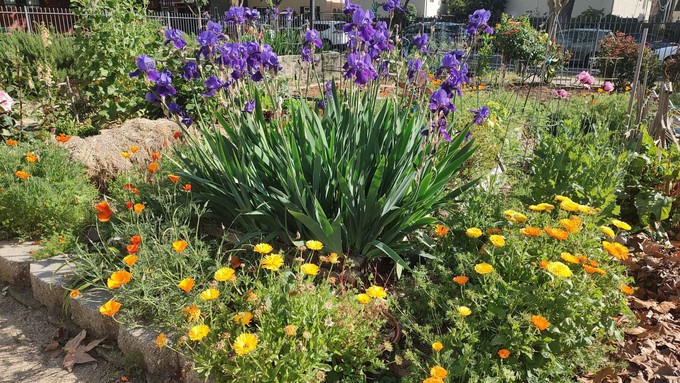
Green Acres' irrigation experts show how to put right plants in the right place for water-wise success

Hydrozoning groups together plants with similar water needs. These combinations also can look as pretty as they are water efficient such as this grouping of bearded irises, calendulas and poppies. Debbie Arrington
How much water does my garden really need? It depends on several factors – including which plants are where.
Putting plants together that share similar needs – including irrigation requirements – is the underlying principle of “hydrozoning.” Learn how during free workshops offered at 10 a.m. Saturday, June 8, at all seven locations of Green Acres Nursery & Supply.
“Irrigation: Hydrozoning Basics” will be June’s “Garden Talk” workshop topic during Green Acres’ series. Garden gurus at each nursery will explain how hyrdrozoning works including examples of plant combinations and suggested irrigation times and amounts. During the one-hour seminar, they’ll also answer questions about irrigation and conversion to a low-water landscape.
No advance registration is necessary. Admission and parking are free.
Also on Saturday, Green Acres will offer a demonstration and tasting of the Big Green Egg charcoal grill, only at its Roseville location. Find out what makes the Big Green Egg so effective and taste some results from 10 a.m. to 2 p.m.
Green Acres’ Roseville nursery is located at 7300 Galilee Road. Other Green Acres nurseries participating in Saturday’s hydrozoning workshops are in Sacramento, Auburn, Citrus Heights, Elk Grove, Folsom and Rocklin.
For addresses, directions and more details: https://idiggreenacres.com/.
Comments
0 comments have been posted.Sacramento Digs Gardening to your inbox.
Food in My Back Yard Series
April 1: Don't be fooled by these garden myths
March 25: Fertilizer tips: How to 'feed' your vegetables for healthy growth
March 18: Time to give vegetable seedlings some more space
March 11: Ways to win the fight against weeds
March 4: Potatoes from the garden
Feb. 25: Plant a fruit tree now -- for later
Feb. 18: How to squeeze more food into less space
Feb. 11: When to plant? Consider staggering your transplants
Feb. 4: Starting in seed starting
Sites We Like
Garden Checklist for week of March 30
Your garden doesn’t mind April showers. Get busy now to enjoy those future flowers.
* Get ready to swing into action in the vegetable garden. As nights warm up over 50 degrees, start setting out tomato, pepper and eggplant transplants.
* From seed, plant beans, beets, cantaloupes, carrots, corn, cucumbers, melons, pumpkins, radishes and squash. (Soak beet seeds overnight in water for better germination,)
* Plant onion sets.
* In the flower garden, plant seeds for asters, cosmos, celosia, marigolds, salvia, sunflowers and zinnias.
* Transplant petunias, zinnias, geraniums and other summer bloomers.
* Plant perennials and dahlia tubers for summer bloom.
* Transplant lettuce and cabbage seedlings.
* April is the last chance to plant citrus trees such as dwarf orange, lemon and kumquat. These trees also look good in landscaping and provide fresh fruit in winter.
* Smell orange blossoms? Feed citrus trees with a low dose of balanced fertilizer (such as 10-10-10) during bloom to help set fruit. Keep an eye out for ants.
* Apply slow-release fertilizer to the lawn.